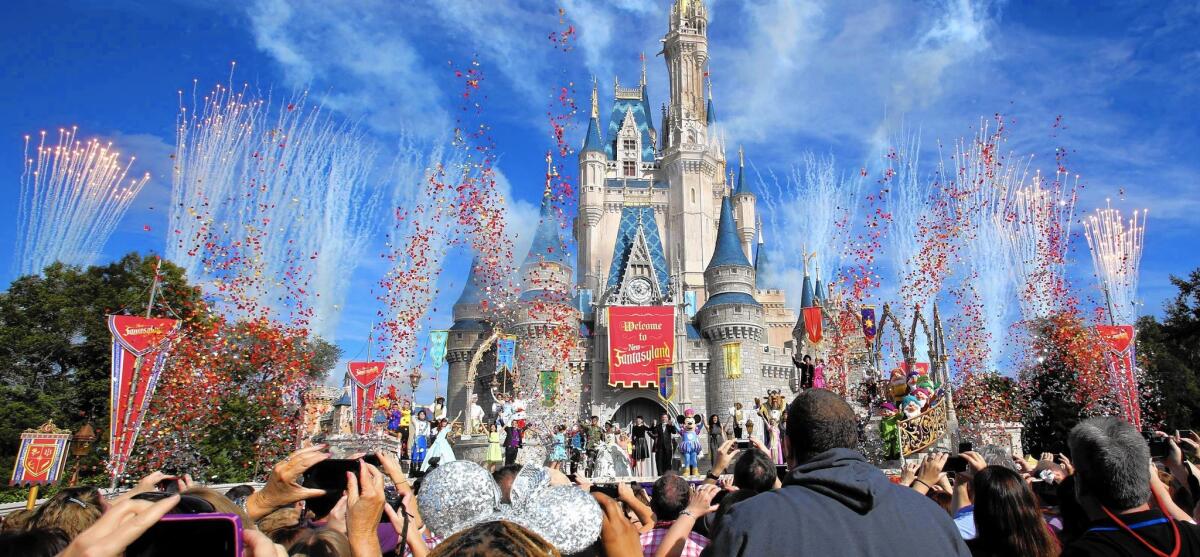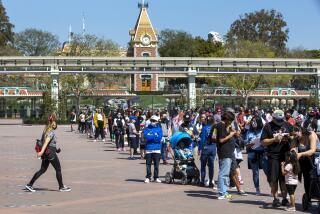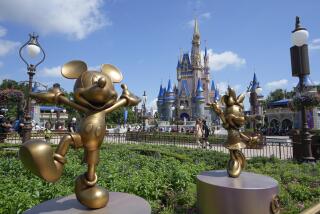No-fly zones over Disney parks face new scrutiny

No-fly zones over Disneyland and Walt Disney World have been in place since 2003.
The “Happiest Place on Earth” has some of the strictest airspace in America.
One day last month, an odd pair of security alerts appeared on the Federal Aviation Administration’s website, reminding pilots that they are not allowed to fly into two areas in Southern California and central Florida.
The sky over Disneyland in Anaheim and Walt Disney World in Orlando is “national defense airspace.” Intentionally violating Mickey and Minnie’s airspace, the alerts warn, could result in interception, interrogation and federal prosecution.
These no-fly zones are known as temporary flight restrictions, like the ones that surround the president when he travels or those put in place above Ferguson, Mo., during protests over the summer. Wildfires, air shows and large sporting events regularly get temporary flight restrictions.
Yet there is nothing temporary about the restrictions over the Disney properties. Such limits do not exist over competing theme parks such as Universal Studios or Knott’s Berry Farm.
The Disney restrictions have been in place since 2003, thanks to a provision quietly slipped into a massive congressional spending bill weeks before the Iraq war. Defense and counter-terrorism officials did not appear to ask for the Disney protections, which were instead urged by at least one Disney lobbyist, according to an Orlando Sentinel investigation in 2003.
The restrictions effectively ended a war between Disney and aerial advertisers who had buzzed over the parks for years before the Sept. 11, 2001, terrorist attacks.
FAA Administrator Michael P. Huerta testified before Congress last year that, if the congressional mandate were removed, the agency would not otherwise grant requests for no-fly zones over Disney properties under existing FAA rules. That 2003 law also made no-fly zones over sporting events permanent; if that law were lifted, an FAA spokeswoman said last week, the agency would consider requests for such zones on a case-by-case basis and consult with other agencies.
------------
FOR THE RECORD:
No-fly zones: An article in the Nov. 10 Section A about flight restrictions over Disney theme parks misstated the Federal Aviation Administration’s positions on no-fly zones over Disney parks and sports events by implying the agency was seeking their removal. FAA Administrator Michael P. Huerta testified before Congress last year that, if the 2003 congressional mandate were removed, the agency would not otherwise grant requests for no-fly zones above Disney properties under existing FAA rules. That 2003 law also made no-fly zones above sporting events permanent. If the congressional mandate for those zones were likewise removed, an FAA spokeswoman said last week, the agency would consider such zones on a case-by-case basis and consult with other agencies. —
------------
Defenders of the zones have said the Disney parks merit special protection because of their importance to American culture and the large crowds they draw. Critics say that the zones, which each cover a three-mile radius, would be useless against a true terrorist attack and that the restrictions instead mostly harm pilots who tow advertising banners.
“Banner towers used to make money with their banner tows around Disneyland; now they’re not allowed to. ... People can’t take aerial photography shots,” said Mark Skinner, owner of Anaheim Helicopters. But “you can fly [around] Knott’s Berry Farm, Six Flags, no big deal,” he said.
According to the Aircraft Owners and Pilots Assn., nearly 100 aerial advertising firms went out of business after Congress codified the no-fly zones over the Disney parks and sporting events. (Pilots have been especially critical of the sporting event no-fly zones, which may last just a few hours but are implemented thousands of times a year.)
Craig Spence, vice president of operations and international affairs for the association, said the restrictions served no real security purpose.
Skinner said even if terrorists attacked Disneyland, no one was actively patrolling the park’s airspace. “If something bad were to happen, how quickly could they get something up there? Not quick enough,” he said. “A plane can cover three miles in literally a minute.”
Richard W. Bloom, director of terrorism, intelligence and security studies at Embry-Riddle Aeronautical University in Prescott, Ariz., said although the no-fly zones were “certainly not foolproof,” they “definitely have a deterring value” as one of many layers of security designed to protect American airspace.
A Disney spokeswoman said the no-fly zones protected the public. “We believe the airspace restrictions over large gathering places like sports stadiums and our theme parks continue to make sense for enhancing public safety,” Cathi Killian said.
When the no-fly zones were approved, however, some of Disney’s public remarks suggested the company was not solely concerned about terrorist attacks.
“The sole and exclusive motivation for seeking these restrictions is for the safety and enjoyment of our guests,” Disney spokeswoman Leslie Goodman told the Orlando Sentinel after the restrictions were created. But Goodman added that “enjoyment” included keeping out “banner ads from trial lawyers” and pilots “buzzing the parks.”
The no-fly zones have been challenged in court, without success.
A Christian group, the Family Policy Network, sued the government in 2003 to allow a pilot to fly a banner that read “Jesus Christ: Hopeforhomosexuals.com” over Walt Disney World during Gay Day. In its court filing, the group argued that the no-fly zone was unfair because Disney didn’t own the airspace and that other theme parks or potential terrorism targets, such as downtown Chicago, didn’t have similar zones.
In response, government attorneys mounted a strident defense of the Disney no-fly zones, saying terrorists could plow planes into crowds of tourists, drop bombs on them, or spray them with chemical or biological agents.
“No building or wall protects bare flesh from the impact of even a small plane. No window or duct tape protects lungs from the invasion of airborne chemicals or germs,” wrote two federal attorneys, one from the Justice Department in Washington and the other an assistant U.S. attorney in Florida. Disney’s place in the American psyche, they argued, warranted the three-mile protective space.
A federal judge threw out the Family Policy Network’s arguments, writing that combating terrorism required “unquestioning adherence” to Congress’ action.
More than a decade later, the attorney who fought the Disney no-fly zone, Steve Crampton, chuckled when he was reminded of the government’s arguments. “Reading it now, it’s kind of a ‘you’ve got to be kidding me, right?’ reaction. Give me a break,” said Crampton, chief counsel for the American Center for Constitutional Rights.
“In the past 10, 12 years since those cases were argued, we’ve seen no further terrorist attacks of the type that took place at the World Trade Center and no real threat in these fly-over zones. I would say, today, that the case for protecting Disney is even weaker than it was when we argued those cases,” Crampton said.
Twitter: @mattdpearce
More to Read
Start your day right
Sign up for Essential California for news, features and recommendations from the L.A. Times and beyond in your inbox six days a week.
You may occasionally receive promotional content from the Los Angeles Times.







